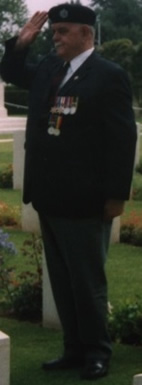A Sappers D-Day
EARLY MARCH 1944
With less than a year's service, I found myself posted to 184 Field Company (Royal Engineers).
A this time this Unit was stationed on what was then Netley Common on the outskirts of Southampton.
It was a large tented camp which the unit was sharing with the Nova Scotia Highlanders of Canada and a Canadian Engineer Company.
On arrival I was to discover that my Unit, together with 83 and 84 Field Companies and 916 Field Park Company (i.e. bulldozers,plants etc) were the 'Engineer' element for the 3rd Canadian Divisions beach group and, as such, we would be in the forefront of the Divisions assault on the 'Atlantic Wall'.
I was eighteen, very green and with no previous experience of landing craft. My only experience would be on Exercise 'Fabius III'. This took place at the beginning of May when we sailed out of Southamptonto land the following morning at the Witterings in West Sussex.
On returning after exrecise, we found that during our four days absence, the camp had been sealedoff. (Apart from two occaisions whan we marched out to form up with other units of the Division for Inspection by VIP's. First by Winston Churchill, General Smuts and Mr MacKenzie King and then by General Montgomery). We were not to leave the camp again until we embarked for D-Day.
The remaining days left to us before embarkation were hectic and an intensive whirl of final preparations, briefings and issueing of the specialist equipment we would carry with us.
among these specialist items were what were known as 'prepared charges' - explosive devices for demolition tasks.
Each of our sections would be required tocarry a 25lbs 'prepared charge'. Our Section Corporal held a ballot for the item and I drew the short straw. Sgt Browm, my Platoon Sgt was most comforting. We were re-rehearsing loading and wearing our kit whan he happened along. I was standing wearing my rucksack, equipment etc, some 100lbs in weight. He stopped to check me over and patting the 'prepared charge' perched on top of my rucksack, chearfully informed me that the charge was quite harmless untill primed with the detonator and fuse. He went on to say that even if hit by a bullet it would be safe and than added "unless it's a tracer". in that case I would save the shilling for a burial blanket. He wandered off chuckling. My reply to his humorous aside is unprintable.
The maps and models used for our briefings were in incredible detail. These, together with the airial photographs, many taken at sea level, enabled us to form a very clear picture of our particular streach of beach, including the beach obstacles and strong points awaiting us.
We discovered that we would be landing on Juno-Nan Beach, right in front of Bernirres-Sur-Mer, and that on disembarking we had to rendezvous by the sea wall. There we would be met by our Platoon Officer (Lt Phillips) and the reconnaissance Sgt and partywho would have been landed with the Asault Infantry (Queens Own Rifles). We were due to land some 30 minutes after the first assault.
Towards the end of May we were issued with French francs thus leaving little doubt to our destination.
Thursday 1st June
Today the Company was addressed by the Commanding Officer, His main comments being:-
a. That he considered it a privilege that we were wearing 3rd Canadian's Divisional Flash and that we would be supporting the Divisional assault on the Atlantic Wall.
b. He Reminded us of the sacrifice by Canada at Dieppe in August 1942 and how the lessons of that tragedy would be of benefit to us in the task ahead.
c. He concluded by expressing his confidence that we would all do our utmost in supporting the Divisions assault.

Juno-Nan-Beach, Bernieres-Sur-Mer June 6th 1949 (approx 11.00 hours)
Canadian Infantry (Nova Scotia Highlanders) coming ashore as first reinforcements, approx 2 hours after first assault. These were part of the Third Canadian Division, Members of my Unit and Myself are by the sea wall (ringed) We had landed 30 minutes after the first assault. We had cleared the mines from behind the sea wall and assisted the (AURES), Armoured Engineers in Churchill Tanks, to clear lanes through the beach obstacles.
Saturday 3rd June
We awoke to discover the camp placed on instant readiness (ready to move in one hour) and to be informed that as of now we were on 'Active Service'. (My Army Discharge book clearly states - Service NW Europe. 3.6.44.
We spent the day in an increasing state of tension. Each hour seemingly longer, until just before last light. Then into camp rolled a large company of TCV's (Troop Carrying Vehicles). Within a short time we had loaded up and were on our way into Southampton Docks.
As we approached the dock area, convoys were approaching from all points of the compass,it was incredible. Yet such was the organisation and control that in a comparatively short time we had threaded our way to our allocated dock basin,where we unloaded and eventually embarked on our LCI - the same one as we had used on exercise 'Fabius III' No Mean feat in the near darkness loaded down as we were. It was amazing that no one finished up in the water as we all had to scramble over several craft before reaching our own vessel.
Our LCI was quite a small vessel. Some 180' long and with a very shallow draught. some 5' at the most.
My platoon accommodation was the forward hold. A steel box some 20' x 20' lined with tiers of steel bunk frames but no bedding because of the fire risk. This was our transport for the Channel crossing.
During the exercise 'Fabius III' we had experienced balmy summer weather and had spent only one night on board. Even then, under almost ideal conditions we had found considerable discomfort. With cramped conditions, and the overall pervading stench of diesel fumes, our Channel crossing would prove to be a far sterner test.
The morning of June 4th saw us still tied up in the dock basin. At about mid-morning we started out of the dock, but with the enormous number of craft involved it was hours before we cleared the docks area to start sailing up the Solent. Suddenly Amazement! We were turning back and all around us other craft were following suit and we would spend the rest of the day returning to dock. Rumours started and then we noticed a rapid deterioration in the weather. It was nearly dark when we finally tied up once more. We were then informed of a 24 hour postponement. Even in the relit ave shelter of the dock basin we were to spend a rough and fitful night. Morning 5th June. With orders to leave our kit aboard, we were disembarked onto the quay to feed and stretch our legs. We were confined to the dockside warehouse for this purpose.
Early afternoon we re-embarked, noting some improvement tn the weather. Later afternoon saw us once again underway. The previous 24 hours had been a considerable trial with everybody getting keyed up and tempers fraying. Now suddenly, everything seemed to change. We could almost feel the urgency of our craft as we progressed up the Solent.
We were fortunate being allowed on deck at this time for as we progressed, what a sight to behold. Before our eyes the Solent was filling with ships and landing craft. From the enormous dock complex of Southampton, from Portsmouth Harbour, the Hamble and every conceivable inlet. Endless streams of vessels were converging and forming into convoys.
At approximately 8pm our flotilla was sailing in line fairly close to the Isle of Wight shoreline. Sailing close and parallel with us were lines of 'Fighting Chasseurs' carrying the 1st SS (Special Service)Brigade commanded by Lord Lovat who, in the morning would land on 'Sword Beach' to go to the support of the 6th Airborne Division.
As we passed Osbourne House with its manicures lawns and its buildings glistening in the evening sunshine, so the sound of Bagpipes echoed across the water. Played I believe by Piper Millen. Cheers rolled across the Solent. It was a moment I will never forget.
Shortly after the Platoon Sgt opened his copy of the sealed orders. Then to inform us that the die was cast. In the morning we would be on the coast of Normandy. Shortly after this momentous news we were ordered off deck. With a last look at home, we went below, in the knowledge that I was in good company as a member of the Third Expeditionary Force to sail to the Continent in the past 30 years, and that history was in the making.
As we cleared the eastern tip of the Isle of Wight, heading for the assembly area some 10 miles out, we became fully aware how rough the seas still were in the aftermath of the storm that had delayed D-Day. Our craft was buffeted by waves 5' to 6'high and we were all very soon reduced to a state of inertia. The only relief from the monotony was at about 1am when the air Armada carrying the 6th Airborne passed over. We could hear their passing even above the pounding of the waves. By morning nothing would deter us from waiting to leave our storm-tossed craft and landing on Terra Firma.
Came the dawn and we struggled to sort ourselves out and prepare for events. We shortly received orders to kit and get into our positions for landing. I was fortunate to be No 2 in the queue to go down the starboard gangplank (Although not appreciated at the time). This meant I was up on deck sheltering behind the forward hatch, but able to see over both sides of the craft.
From approximately 10 miles out we started at our run into the beach. What an astonishing sight to behold. First we passed close to HM ships, Warspite, Ramillies and the Lord Roberts. All engaging shore targets with their main armament. Next we passed very close to HMS Scylla, Flagship of the Eastern Task Force. Then HMS Belfast and Diadem and finally through the destroyer and gunboat screen. Everyone seemed to be shooting. The noise was deafening.
With about a mile to go we received the warning for beaching and, hitching up our kit we awaited events. At this time I was fully aware of the 25lbs of explosive perched on my back.

With a hard jolt we beached and i found myself instinctively following Sgt Brown down the gangplank, plunging off into chest high water we waded ashore. To my amazement there in front of me was the sea wall at Bernieres, We had landed exactly as planned during briefing.
As previously ordered, we quickly gathered by the sea wall and began to take stock. We were not left waiting. Sgt Brown quickly started to issue orders and I found myself with my section ordered to clear mines from the dunes on top of the sea wall. The rest of the Platoon were set to workon the mass of obstacles along the forshore; many of these being mined. Armoured Bulldozers were already ar work and AVRE's had already flailed and cleared two exits off the beach.
The landings at Bernieres had been further delayed by bad weather. Starting some 30 minutes late. This was to cause a considerable handicap in the beach clearance with the tide coming back in to cover many obstacles before they could be finally cleared. It would take until early afternoon before the beach could be reasonably cleared. Nevertheless sufficent progress was made to enable the follow up Brigade and Artillery units to start landing some two hours after the H-Hour.
On starting our clearance task I found myself as No1 in a clearance team, i.e. operating a mine detector. Thus equipped I started sweepin the area chosen. I stopped almost immediatly. There staring at me was my first mine. Indicating to me No2 whose job was to mark the mines as found. He came forward to place a marker. Then he stopped. We looked at each other then back at the mine. Neither of us had seen or been instructed concerning the mine in question. (It turned out to be Belgian).
This type of problem would occur again befor the end of the day. Too late it was realised that during our all too brief training in the UK many of us had seen and handled only Brittish, German and Italian types of mines.
The problem was overcome but only at the expense of unnecessary casualties. In the meantime work had to proceed.
On landing few of us paid much attention to the conditions on the beach, being intent on reaching our RV point by the sea wall; but now as we got to work, we began to realise how fortunate we had been. There were a considerable number of casualties around. As well as wrecked tanks and landing craft all along the beach we now discovered that all of our reconnaissance party were among the casualties. Lt Phillips, the Sgt and two of the sappers were dead. By the end of the day some 20% of the Platoon would be among the toll.
About two hours after H-Hour, the follow up brigade started landing. We were quite surprised whwn from a fresh wave of LCI's The Nova Scotia Highlanders can
me streaming ashore carrying folding bicycles. At the time, Jerry was still barely a mile up the road and one of our wags called out that they would not be able to claim milage allowance. Nevertheless the Nova Scotia Highlanders would have the last laugh by making the deepest Infantry penetration inland on D-Day.
Early evening an alarm was raised to the efect that a German counter-attack had broken through to the beach between us and Sword beach. Everone stood to. We waited events with some aprehension. Time ticked by with tension mounting. Suddenly from across Channal came the sound of many aircraft. The noise getting louder and louder. Raising above the current sounds all aroundus. And there, what a sight to behold. The 6th Air Landing Brigade coming in to reinforce the 6th Airbourne Division. some 500 tugs with gliders in tow. As spontaneous cheering echoed around the beach the gliders were detatching and swooping into land. Although the sky seemed to be filled with anti-aircraft fire, very few aircraft seemed to be hit.
With the arrival of the Airbourne reinforcement all tension had vanished. The general feeling being that we wre here to stay.
Just before last light some 4 or 5 German bombers appeared overhead, dropping bombs at random. All being shot down for their cheek. It seemed to put the seal on D-Day although not quite.
As a young green sapper, I hoped I had played my part on an Historical Day. I had been lucky and seen the D-Day sunset. Some did not.
Capt L G Butt
Ex D-Day Sapper
184 Field Coy R.E.
Postscript. On the occaision of the 60th Aniversary of D-Day, Len returned to Juno Beach and the Bayeux cemetary.
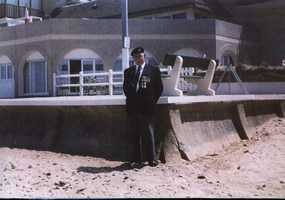
Len Butt standing at the approximate spot where he had Landed on D-Day.
The Photo was taken exactly 60 years later
- The 60th Anniversary of D-Day
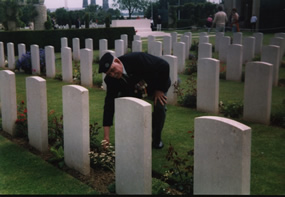 Len Butt, (Ex D-Day Sapper)
Len Butt, (Ex D-Day Sapper)
Laying a wreath on the Grave of
Sgt J.A.Brown R.E.
His Platoon Sgt, killed during the assault landing on Juno-Nan-Beach on
D-Day 6th June 1944
The Wreath being laid on 6th June 2004
The 60th Anniversary of D-Day.
(Bayeux War Cemetery)
 Len Butt, (Ex D-Day Sapper)
Len Butt, (Ex D-Day Sapper)
Paying Respects at the the Grave of
Sgt J.A.Brown R.E.
His Platoon Sgt, killed during the assault landing on Juno-Nan-Beach on
D-Day 6th June 1944
The Wreath being laid on 6th June 2004
The 60th Anniversary of D-Day.
(Bayeux War Cemetery)
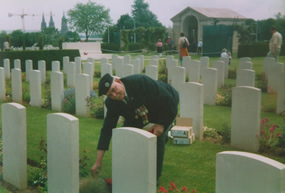 Len Butt, (Ex D-Day Sapper)
Len Butt, (Ex D-Day Sapper)
Laying a wreath on the Grave of
Lt E.G.H. Phillips.
His Platoon Officer, killed during the assault landing on Juno-Nan-Beach on
D-Day 6th June 1944
The Wreath being laid on 6th June 2004
The 60th Anniversary of D-Day.
(Bayeux War Cemetery)
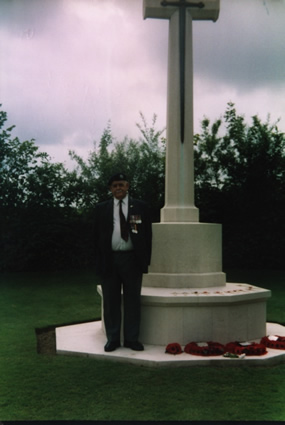
Len Butt, Paying Respect at the Cross of Remembrance "Jerusalem" War Cemetary Normandy June 6th 2004

